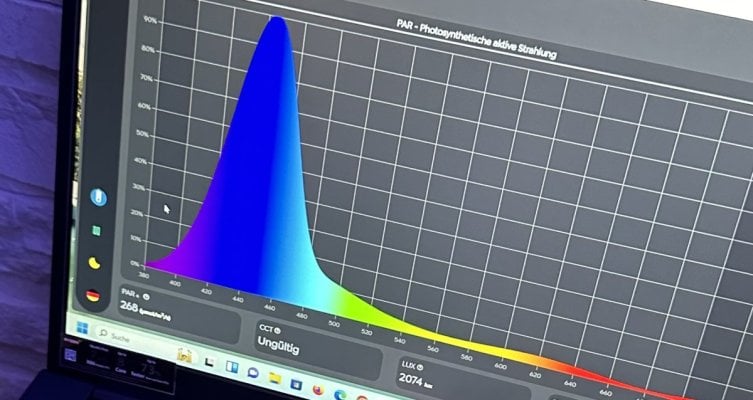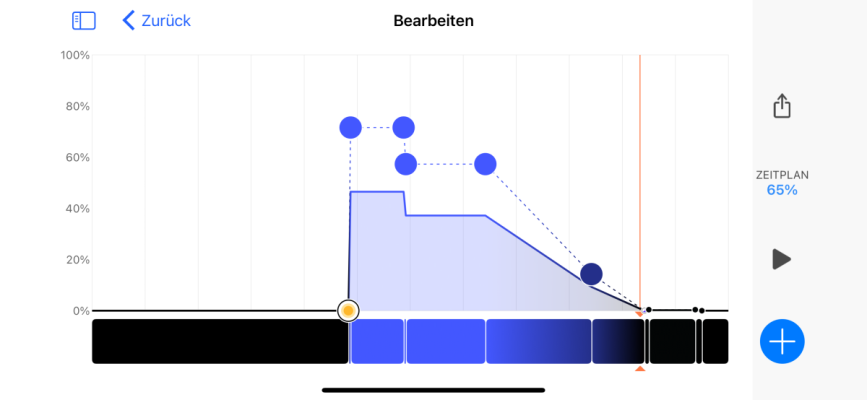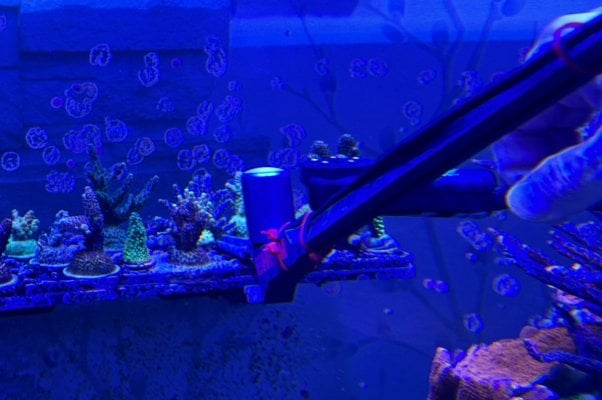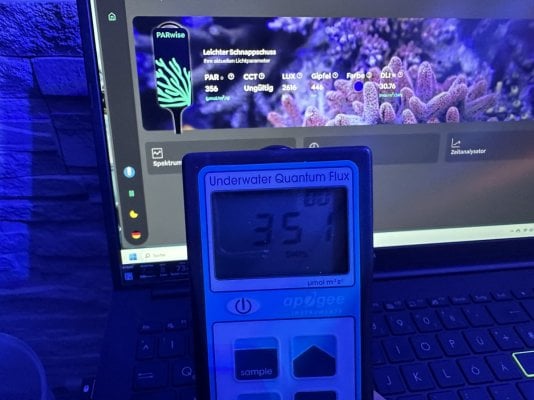Navigation
Install the app
How to install the app on iOS
Follow along with the video below to see how to install our site as a web app on your home screen.
Note: This feature may not be available in some browsers.
More options
You are using an out of date browser. It may not display this or other websites correctly.
You should upgrade or use an alternative browser.
You should upgrade or use an alternative browser.
Apogee mq-510 vs. ITC Parwise issue?
- Thread starter cubalibre79
- Start date
- Tagged users None
I can't really help because I only own the 510. There is some info on both below that may help.

 www.reef2reef.com
www.reef2reef.com

Apogee or Parwise
Is the Parwise meter any different from the Apogee MQ-510 in terms of reading results? Meaning, if a spot in my tank is 270 PAR per the Apogee, will the Parwise produce a very similar reading in the same spot? Is this an apples to apples comparison with these two meters?
 www.reef2reef.com
www.reef2reef.com
Upvote
0
PARwise does read lower.
360 is a good par and use the parwise to dial in the color channels.
Edit: if you follow the link to the link on humble.fish, telegram talks about the different meters. He says use a multiplier of 1.26 on the parwise. Makes sense.
360 is a good par and use the parwise to dial in the color channels.
Edit: if you follow the link to the link on humble.fish, telegram talks about the different meters. He says use a multiplier of 1.26 on the parwise. Makes sense.
Last edited:
Upvote
0
yes I’m fine with 360 par.PARwise does read lower.
360 is a good par and use the parwise to dial in the color channels.
Edit: if you follow the link to the link on humble.fish, telegram talks about the different meters. He says use a multiplier of 1.26 on the parwise. Makes sense.
but should i trust in apogee and set it to 65% intensity? or should i try in Parwise and set it to 100% intensity?
maybe someone can help who uses also multiple xr30 over his tank is 65% a good point to be ?
Upvote
0
Set it to the apogee @ 65%.yes I’m fine with 360 par.
but should i trust in apogee and set it to 65% intensity? or should i try in Parwise and set it to 100% intensity?
maybe someone can help who uses also multiple xr30 over his tank is 65% a good point to be ?
I assume you get a reading of about ~285 par with parwise?
I think I'm about 200ish with my parwise at the top of my rock, I'll have to check.
Upvote
0
I‘m off work & check it out.Set it to the apogee @ 65%.
I assume you get a reading of about ~285 par with parwise?
I think I'm about 200ish with my parwise at the top of my rock, I'll have to check.
You are close, if i set intensity with a wwc schedule to 65%, my apogee reads ~ 360 par and the ParWise reads ~ 250 to 270 par.., in the first phase, before it turns into blue period.

Last edited:
Upvote
0
I think I remember that @telegraham tested both and if you multiply the PARwise number by 1.26 you basically get the Apogee number (i.e. it reads that much lower than the Apogee).
If that's the case, then your PARwise's 270 x 1.26 = 340 which is pretty darn close to the Apogee's 360.
If that's the case, then your PARwise's 270 x 1.26 = 340 which is pretty darn close to the Apogee's 360.
Upvote
0
I‘m just a private user, so I have no lab here. But if i turn my intensity to 100% the apogee 510 show me ~ 580 par and the parwise 360.I think I remember that @telegraham tested both and if you multiply the PARwise number by 1.26 you basically get the Apogee number (i.e. it reads that much lower than the Apogee).
If that's the case, then your PARwise's 270 x 1.26 = 340 which is pretty darn close to the Apogee's 360.
Feels like so higher the par is, so wider the angle between both. 360 x 1.26 is ~ 450 range and not 580.
and 100% is way too much here, and definitely burn corals, one Hysterix bleached out very fast
Upvote
0
- Joined
- May 20, 2017
- Messages
- 590
- Reaction score
- 795
1.26X is at something similar to AB+. You're challenging the PARwise with all channels. There's also the issue of holding the PARwise level. I'm just a private user, too. I've compared the PARwise to two different 500-series Apogees and the VBR. I don't trust the PARwise readings. The VBR is a better budget meter. And don't get me started on the PARwise as a spectrometer. Even ITC will tell you it's not a spectrometer.Feels like so higher the par is, so wider the angle between both. 360 x 1.26 is ~ 450 range and not 580.
Upvote
0
Thank you very much, this helps a lot. So the ParWise is just more a toy than a tool!!1.26X is at something similar to AB+. You're challenging the PARwise with all channels. There's also the issue of holding the PARwise level. I'm just a private user, too. I've compared the PARwise to two different 500-series Apogees and the VBR. I don't trust the PARwise readings. The VBR is a better budget meter. And don't get me started on the PARwise as a spectrometer. Even ITC will tell you it's not a spectrometer.
After i adjust to the apogee the tank looks good and the corals react very well, polyps came slowly back out
I think it was way too much before.
Upvote
0
I personally trust the PARwise more than I did the Apogee. I wasn't getting great results with my Apogee PAR readings in my Acro system and when I noticed the 100 PAR difference between the two, I adjusted to the PARwise to see and the Acros responded very nicely.
So which one is accurate? I obviously don't know that from a scientific level, but I use the PARwise to adjust.
So which one is accurate? I obviously don't know that from a scientific level, but I use the PARwise to adjust.
Upvote
0
I'm just annoyed by these differences. I think a par meter should show par! There are comparisons between LiCor / Apogee / and ParWise, and there are also ITC videos where it is explained to us that Apogee uses old technology and therefore Parwise would be more accurate in relation to the respective spectrum. There are also videos from BRS about 4 radions where around 1000 pars are achieved with 100% and 6" deep. I don't know what I can believe anymore. And the fact that there are animals under the lamps takes some of the fun out of the differences.I personally trust the PARwise more than I did the Apogee. I wasn't getting great results with my Apogee PAR readings in my Acro system and when I noticed the 100 PAR difference between the two, I adjusted to the PARwise to see and the Acros responded very nicely.
So which one is accurate? I obviously don't know that from a scientific level, but I use the PARwise to adjust.
Upvote
0
If I trust Apogee and set about 360 par with 4 xr30's over my 63" tank, up by the acropores... then it consumes about 300 watts. A little bit, in my opinion. If I trust the ParWise I have to go to 100% intensity to achieve this 360 par. All 4 lamps then consume ~ 460 watts. Since they are the Pro ones and they lose performance anyway, I think 100% is realistic. Maybe someone can compare this with me? Please.
Upvote
0
Edit: omg that was long. TL;DR, it's complicated.
I understand the frustation on differences in measurements between instruments. Note that this is a common frustration in many different scientific instruments. Personally, I think what is important is understanding your instrument and the measuements relative to how your corals respond. If your acros do well at 260 PAR on a Parwise, then that works as a point of reference for that meter (whereas a 360 on an apogee may be your benchmark). With that knowledge, you can plan your coral scaping. The belief that "PAR is PAR is PAR" may be a mistake. If the apogee were a perfect instrument, perhaps that would be true, but lets imagine that it is more sensitive to a certain bandwidth of the spectrum, thus overestimating PAR with spectra heavy in that range or maybe underestimating PAR for the rest. I don't know if this is possible or not. But let's also imagine that 360 PAR coming from Radions might affect your Walt Disney Acro differently than 360 PAR from an AI Hydra. If that were the case, the PAR 360 benchmark is only relevant for the Radion that you know works well at that intensity for your Walt Disney (and likely also the spectrum you choose). How about an old Radion vs a new one? Would be lovely if we knew for fact that 360 PAR from any spectrum you choose from any light works well for an Acro, but I just don't know if that is true. En fin, I consider these instruments imperfect and use them as a tool (not a toy) for adjusting my lights to the needs of the corals for the levels I know work through trial and error, also considering the state of my tank regarding nutrition and hospitable environment, and maintianing those levels over time.
I understand the frustation on differences in measurements between instruments. Note that this is a common frustration in many different scientific instruments. Personally, I think what is important is understanding your instrument and the measuements relative to how your corals respond. If your acros do well at 260 PAR on a Parwise, then that works as a point of reference for that meter (whereas a 360 on an apogee may be your benchmark). With that knowledge, you can plan your coral scaping. The belief that "PAR is PAR is PAR" may be a mistake. If the apogee were a perfect instrument, perhaps that would be true, but lets imagine that it is more sensitive to a certain bandwidth of the spectrum, thus overestimating PAR with spectra heavy in that range or maybe underestimating PAR for the rest. I don't know if this is possible or not. But let's also imagine that 360 PAR coming from Radions might affect your Walt Disney Acro differently than 360 PAR from an AI Hydra. If that were the case, the PAR 360 benchmark is only relevant for the Radion that you know works well at that intensity for your Walt Disney (and likely also the spectrum you choose). How about an old Radion vs a new one? Would be lovely if we knew for fact that 360 PAR from any spectrum you choose from any light works well for an Acro, but I just don't know if that is true. En fin, I consider these instruments imperfect and use them as a tool (not a toy) for adjusting my lights to the needs of the corals for the levels I know work through trial and error, also considering the state of my tank regarding nutrition and hospitable environment, and maintianing those levels over time.
Upvote
0
- Joined
- May 20, 2017
- Messages
- 590
- Reaction score
- 795
I have four PAR meters, three of which align. That excludes the UPRtek and Hopoocolor spectrometers. Three of those PAR meters are two 500-series Apogee and one VBR. The outlier is the PARwise.Thank you very much, this helps a lot. So the ParWise is just more a toy than a tool!!
Testing suggests that if you set up lighting using the PARwise, you're in good shape. If you set up lighting with an Apogee 500-series, then move to the PARwise, that could be, and has been, bad for some. The PARwise will read low when compared to the 500-series Apogees.I'm just annoyed by these differences.
Your corals don't care about accuracy. Don't mix PARwise and Apogee readings.
Upvote
0
Then I’ll adjust to the parwise and give it some time. Maybe 4 weeks, and I’ll see if it works better.I have four PAR meters, three of which align. That excludes the UPRtek and Hopoocolor spectrometers. Three of those PAR meters are two 500-series Apogee and one VBR. The outlier is the PARwise.
Testing suggests that if you set up lighting using the PARwise, you're in good shape. If you set up lighting with an Apogee 500-series, then move to the PARwise, that could be, and has been, bad for some. The PARwise will read low when compared to the 500-series Apogees.
Your corals don't care about accuracy. Don't mix PARwise and Apogee readings.
Upvote
0
Hello again,I have four PAR meters, three of which align. That excludes the UPRtek and Hopoocolor spectrometers. Three of those PAR meters are two 500-series Apogee and one VBR. The outlier is the PARwise.
Testing suggests that if you set up lighting using the PARwise, you're in good shape. If you set up lighting with an Apogee 500-series, then move to the PARwise, that could be, and has been, bad for some. The PARwise will read low when compared to the 500-series Apogees.
Your corals don't care about accuracy. Don't mix PARwise and Apogee readings.
some scary things happened to me and my parwise.. but today it happens the second time, i pick up my parwise and wanna see if there is something new, maybe an update or something else.
So i take some readings with my apogee mq 510 and with the parwise.
I read 75 Par difference at the same spots. Then i let the parwise hanging in the water for maybe 1 minute.. and my wife say, oh look some air bubbles leave the parwise!! maybe it’s not sealed anymore, it’s weak!
I saw that and I’m confused …
I try to measure the same spots again and what should i say
 completely the same readings as to my apogee … and no! I need no doctor, it’s all fine with me
completely the same readings as to my apogee … and no! I need no doctor, it’s all fine with me But take a look my wife try to fix that on a few screenshots…
ℹ can’t explain that, but I have never seen such a close reading before

Attachments
Upvote
0























